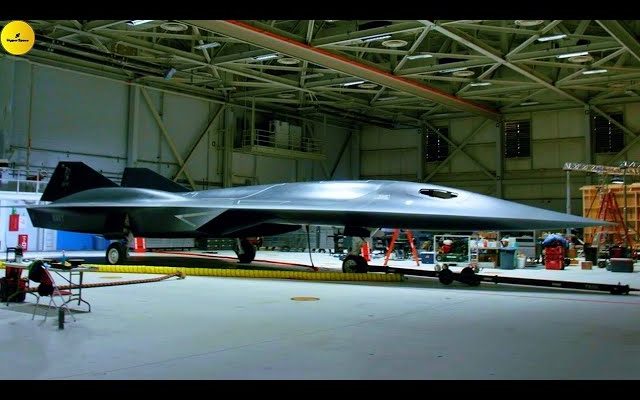Elon Musk has once again stirred excitement in the aerospace and defense communities with the revelation of the real SR-72 Darkstar, a high-speed, hypersonic aircraft set for deployment by 2025. Building on Musk’s reputation for pushing the boundaries of technology, the SR-72 Darkstar promises to revolutionize both military and civilian aviation, delivering unprecedented speeds and capabilities. But what exactly is the SR-72 Darkstar, and how will it impact both the aerospace industry and global defense strategies?
The SR-72 Darkstar: Origins and Design
The SR-72 Darkstar draws inspiration from the now-iconic SR-71 Blackbird, a legendary reconnaissance aircraft developed by Lockheed’s Skunk Works in the 1960s. Known for its incredible speed—capable of flying at Mach 3—the SR-71 held the record for the world’s fastest jet aircraft for decades. The SR-72 Darkstar is designed to be its modern successor, but it has a bold new ambition: to reach hypersonic speeds of Mach 6 (six times the speed of sound).
The SR-72 Darkstar is being developed by SpaceX, Musk’s aerospace venture, leveraging cutting-edge technologies that have already revolutionized the space industry, including the Falcon 9 rocket and the Starship program. While specific details of the SR-72’s construction remain classified, reports suggest that the aircraft will combine an advanced engine design, likely utilizing a combination of scramjet and turbine engines, to achieve its incredible speed.
The Darkstar will be primarily a reconnaissance and strike platform, designed to operate in high-threat environments and conduct missions over vast distances in a fraction of the time required by current aircraft. Unlike conventional jets that rely on turbojet engines, hypersonic aircraft like the SR-72 will use scramjets that can compress air at extremely high speeds, allowing them to maintain the incredible velocities necessary for hypersonic flight.
The Strategic Implications
The SR-72 Darkstar’s ability to travel at hypersonic speeds represents a quantum leap in military aviation. This new class of aircraft is expected to be able to perform missions at far greater speeds and with far less warning than current aircraft. For example, a hypersonic jet like the SR-72 could fly from one continent to another in a matter of hours, reaching enemy territory before a response could be mobilized.
For the U.S. military, the SR-72 could serve a dual purpose: as a reconnaissance aircraft and as a potential strike platform. Its speed would allow it to penetrate hostile airspace and collect intelligence or deliver precision-guided munitions with minimal risk of interception. In high-threat scenarios, it could evade enemy defenses with ease, utilizing its speed and low radar signature.
In the broader geopolitical landscape, the SR-72 Darkstar’s deployment could shift the balance of power. While countries like Russia and China are also heavily invested in hypersonic technologies, Musk’s announcement indicates that the U.S. could be on the verge of deploying a hypersonic platform that is not only faster but also more versatile and stealthy. This technological advancement will undoubtedly heighten tensions between major powers, as the implications of such a speed advantage in military engagements are far-reaching.
The Civilian Angle
While the SR-72 is primarily a military aircraft, Musk has hinted that similar technologies could eventually find their way into civilian aviation. Hypersonic flight could revolutionize long-distance travel, shrinking travel times on global routes. A flight from New York to Tokyo, which currently takes about 14 hours, could be completed in less than two hours, fundamentally altering the global aviation landscape. This level of innovation could not only reshape commercial air travel but also open new doors for private aerospace ventures.
Challenges and Hurdles
Despite the excitement, there are significant technical challenges in developing a hypersonic aircraft capable of sustained Mach 6 flight. These include issues related to heat resistance, fuel efficiency, and the stresses placed on the airframe at such extreme speeds. The SR-72 Darkstar will need to overcome these hurdles before it can be deployed in 2025. Moreover, the global strategic and political implications of deploying such a powerful aircraft will likely trigger new discussions on arms control and military technology races.
Conclusion
Elon Musk’s revelation of the SR-72 Darkstar represents a bold leap into the future of aviation, one that blends cutting-edge aerospace technology with a vision of global connectivity and defense superiority. With the potential to reach Mach 6 and dramatically alter the way military missions are conducted, the SR-72 Darkstar is poised to be a game-changer. As it undergoes development and is eventually deployed, it will not only reshape how the U.S. military approaches warfare but could also lay the foundation for the next generation of high-speed commercial air travel. Whether it will “scare” adversaries or spark a new arms race, the SR-72’s arrival by 2025 is something the world will be watching closely.



